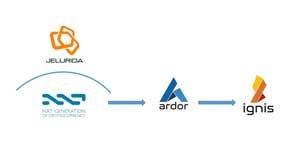
I’ll never forget the first whitepaper I read in the blockchain space. No chocolate fish for guessing which one. It was the Bitcoin whitepaper of course! I was procrastinating mainly because I was scared. Scared because the 9 pages felt like hieroglyphics. In the end I bit the bullet and when my daughter was born in September 2014 I took 4 weeks off to read the whitepaper that I had mentally prepared myself for. Oh, I also helped my wife out as well :). The 9 pages to 2 hours to read but 2 months to digest. I knew the words I was reading but couldn’t understand what I was reading. Fast forward 3 years and I never thought I would be reading 2-3 whitepapers a week.
Anyone can read whitepapers and the average length these days ranges from 10-30 pages. They come in all shapes and sizes.
- There’s the traditional academic 1 or 2 column with an abstract whitepaper such as Siacoin, IOTA and Augur. These are characterised by including lots of mathematics and black print.
- Storj lived a little dangerously and added colour to the traditional academic paper. This was only to the diagrams though.
- Humaniq expanded on this and put in a coloured world map and a fancy cartoon like graphic. They also introduced some coloured text and believe it or not a table of content!
Coloured whitepapers, much like coloured television were becoming mainstream!
- Graphical whitepapers such as Status and LA Token started appearing that had a dedicated coloured front page. LA Token went next level compared to Status. Different font sizes in different colours were experimented with along with attractive bar charts and believe it or not the introduction of team members!
- “Marketing brochure” whitepapers such as Civic and Monaco then appeared. These brought in some new images, more so Monaco than Civic, that looked beautiful and attractive to try and create an emotional connection with the reader. Too bad they were meaningless and made the “whitepaper” look bigger than it actually was.
Everyone replicate the essence of the whitepaper on bitcointalk along with the token sale criteria and terms and conditions.
On a serious note
The evolution of whitepaper has followed the evolution of token sales. To stand out from the crowd, whitepapers have become more user friendly to read with less focus on the technical and more on the use case on why a token is needed and the purpose it serves.
Reading a 20 page whitepaper usually only takes a few hours. Understanding it takes a lot longer. My process usually follows something like this:
- Read the whitepaper and typically still don’t fully understand it.
- Visit the website and may understand it better.
- Find the team page to see who I may know or have heard of before. This is just out of curiosity.
- Check out the bitcointalk forums and spend maybe 4 hrs trolling through the pages reading comments and getting the sentiment of the project. It also provides my daily humour because there are some funny trolls out there.
- Check other social media channels which are usually quite boring.
- Do some YouTube searches and Google for dirt. This is the best part. Sometimes you’ll get someone who puts it all on the line and calls the project out. Bancor and Filecoin are two examples.
Funny that Filecoin currently holds the record for highest raised at $257M and Bancor is 5th at $153M. Side note, Tezos at #2 spot with $232M raised is a work in progress. Are you starting to see a connection?
Conclusion
Is there a right way and a wrong way to write ICO whitepapers? (Say that fast 10 times!) The answer is no. As long as you get your message across and achieve your goal, you should be happy. Typically a whitepaper should convey what is you are building and how it works. I mean how it really works. Not fluffy stuff. A seperate sales token document is useful and the team should stay on the webpage. This allows me to read the whitepaper without being distracted by faces, the token supply, distribution and issuance rate. It allows me to read the token sales economics once I’ve understood the value prop. And then I can scour the website to see if orange is truly the new black, or if pink is becoming the new blue.

